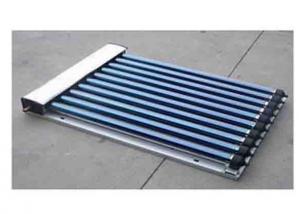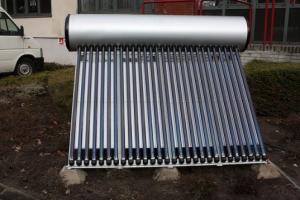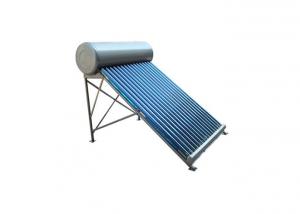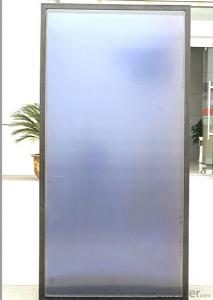Active Solar Collectors - Flat Panel Solar Water Heater Collector 2024
- Loading Port:
- Shanghai
- Payment Terms:
- TT OR LC
- Min Order Qty:
- 500 pc
- Supply Capability:
- 10000 pc/month
OKorder Service Pledge
OKorder Financial Service
You Might Also Like
Specifications
Solar collector is high efficient,stable performance,it is widely used in domestic hot water system and commercial solar project
Solar collector is a device that absorbs thermal energy from the sun and converts it into usable heat. The heat is normally absorbed by water, or a freeze resistant water mix, which can then be used to supplement hot water heating, space heating and even space cooling via use of an absorption chiller or dessicant cooler technology.Special designed for the Heat-pipe solar water heater systems. It's easy to combine with existing water heating systems for commercial, buildings, hotels, hospitals, swimming pools etc.Excellent figure, reliable performance, low maintenance, covenient replacement. One or several glass tubes broken will not fluence system work. Suitalbe to use in all kinds of climates.
Technology:
1.The upright tank can make the water temperature to different level. It can hot the top water instantly. The special structure can reduce the cold and hot water to mix together.
2.The tank inside the building, the connection pipe between the tank and water tap is very short, so that hot water can be used instantly and seldom cold water flows out.
3.The tank inside the building, the hot water loses less energy than the normal one
4. Flat penal Solar collector is high efficient,stable performance
5. Flat panel Solar power collector is a device that absorbs thermal energy from the sun and converts it into usable heat
6. 50mm fiberglass insulation and EPDM seal strip to ensure the solar collector can work under cold temperature.
7. Ultrasonic welding technology to joint the tube and fin together perfectly.
8. Blue/black chrome coating has high absorption fate to ensure excellent efficiency.
9. The Absorber is made of all-copper or aluminum-copper complex absorber plate.
10 . Cover sheet material is toughed glasses.
11. Special anodized aluminum alloy frame ensures handsome appearance and can bear high pressure without leakage.
12. High heat collecting rate of 97%, low reflection rate of 3% .
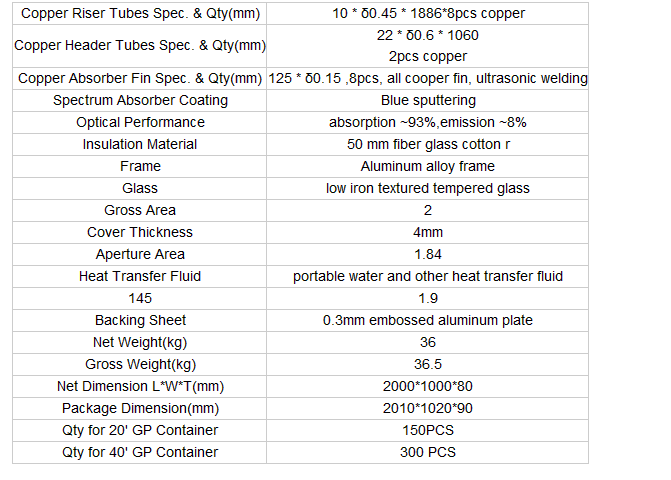
- Q: Can solar collectors be used for heating temples?
- Yes, solar collectors can indeed be used for heating temples. Solar collectors, such as solar thermal panels or solar water heaters, can harness the sun's energy and convert it into heat. This heat can then be utilized to warm up the interior spaces of temples, providing a sustainable and environmentally friendly heating solution.
- Q: Can solar collectors be used for heating car storage facilities?
- Yes, solar collectors can be used for heating car storage facilities. Solar thermal collectors are designed to capture the sun's energy and convert it into heat, which can then be used for various purposes such as heating air or water. By installing solar collectors on the roof or walls of a car storage facility, the captured heat can be used to maintain a comfortable temperature inside the facility, reducing the need for traditional heating methods and saving energy costs.
- Q: Can solar collectors be used for heating refineries?
- Yes, solar collectors can be used for heating refineries. Solar thermal technologies, such as concentrated solar power (CSP) or solar water heating systems, can provide heat through direct or indirect methods to meet the heating requirements of refineries. These collectors can harness solar energy to generate high-temperature steam, which can then be utilized in various refinery processes, such as oil distillation, desalting, or hydrogen production. Implementing solar collectors for heating can help reduce the reliance on fossil fuels, decrease greenhouse gas emissions, and contribute to a more sustainable and environmentally friendly operation of refineries.
- Q: Are there any financial benefits to installing solar collectors?
- Yes, there are several financial benefits to installing solar collectors. Firstly, solar collectors can significantly reduce your electricity bills. By harnessing the power of the sun to generate electricity, you can offset a significant portion of your energy consumption, resulting in lower monthly electricity costs. Additionally, many countries and states offer financial incentives for installing solar collectors. These incentives can include tax credits, grants, and rebates, which can help offset the upfront costs of installation. Some regions even have net metering policies, allowing you to sell excess electricity back to the grid, further reducing your electricity costs or potentially earning you money. Moreover, solar collectors can increase the value of your property. Studies have shown that homes equipped with solar panels sell faster and at higher prices compared to those without. This means that the investment in solar collectors can pay off in the long run if you decide to sell your property. Lastly, installing solar collectors can protect you from rising energy costs. As traditional energy prices continue to increase, your solar collectors will continue to provide you with free and renewable energy, shielding you from future price hikes. Overall, the financial benefits of installing solar collectors are clear. They can reduce your electricity bills, provide financial incentives, increase property value, and protect against rising energy costs.
- Q: How much space is needed to install a solar collector?
- The space required to install a solar collector varies depending on the size and type of the collector. Generally, for residential installations, a solar collector can range from a few square feet to a few hundred square feet. It is important to consider factors such as the available sunlight, roof orientation, and shading when determining the space needed for a solar collector.
- Q: Can solar collectors be used for heating churches and religious buildings?
- Yes, solar collectors can be used for heating churches and religious buildings. Solar thermal systems can provide heat for space heating and hot water needs. By harnessing solar energy, these collectors can help reduce energy costs and carbon emissions while providing warmth to these places of worship.
- Q: Can solar collectors be used for heating textile manufacturing plants?
- Yes, solar collectors can be used for heating textile manufacturing plants. Solar thermal systems can provide cost-effective and sustainable heating solutions by converting sunlight into heat energy. This renewable energy source can be used to heat water or air, which can then be used for various heating applications in textile manufacturing plants, such as dyeing, drying, or space heating. By utilizing solar collectors, textile manufacturing plants can reduce their reliance on fossil fuels, lower energy costs, and decrease their carbon footprint.
- Q: Are solar collectors suitable for agricultural greenhouses?
- Yes, solar collectors are suitable for agricultural greenhouses. They can effectively capture and convert solar energy into heat, which can be used for maintaining optimal temperature and providing supplemental heating in greenhouses. This helps in enhancing plant growth, extending the growing season, and improving overall crop yield. Additionally, solar collectors offer a sustainable and cost-effective solution for greenhouse operations by reducing reliance on traditional energy sources.
- Q: Can solar collectors be used for drying pet products?
- Solar collectors can indeed be utilized for the purpose of drying pet products. These collectors, known as solar dryers or solar dehydrators, harness the power of the sun to warm the air and subsequently desiccate the items contained within. A wide range of pet products, comprising pet food, treats, toys, and bedding, can be effectively dried using these devices. Solar drying boasts both environmental and economical benefits, as it operates without the need for electricity or gas. Furthermore, this method aids in maintaining the nutritional value and overall quality of the pet products, rendering it a favorable choice for both pet owners and those involved in the pet industry.
- Q: How long does it take to recoup the cost of installing solar collectors?
- The length of time it takes to recoup the cost of installing solar collectors can vary depending on several factors such as the initial cost of installation, the amount of energy generated, the cost of electricity, and any available incentives or tax credits. On average, it can take anywhere from 5 to 15 years to recoup the initial investment. However, with the decreasing cost of solar technology and the potential for long-term energy savings, the payback period is becoming shorter, making solar collectors a more financially viable option for many homeowners and businesses.
Send your message to us
Active Solar Collectors - Flat Panel Solar Water Heater Collector 2024
- Loading Port:
- Shanghai
- Payment Terms:
- TT OR LC
- Min Order Qty:
- 500 pc
- Supply Capability:
- 10000 pc/month
OKorder Service Pledge
OKorder Financial Service
Similar products
Hot products
Hot Searches
Related keywords






